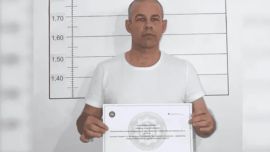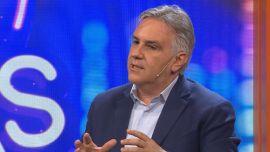From May 19, the second documentary film directed by Alejandro Hartmann and produced by Vanessa Ragone will arrive on Netflix. It’s impossible not to associate this new creation of theirs, titled El fotógrafo y el cartero: el crimen de Cabezas (in English, The Photographer: Murder in Pinamar) with their first from 2020, Carmel: ¿Quién mató a María Marta? (Carmel: Who Killed Maria Marta?). Both benefit from impressive documentation and research and feature unknown voices expanding on a story of great intrigue.
In this latest film, a documentary probing the murder of late Noticias photographer José Luis Cabezas, there are no chapters, with the story concentrated in 105 minutes.
What are the exclusive testimonies that you obtained for the film?
ALEJANDRO HARTMANN: For example, the clerk of the court, Mariano Cazeaux [trial judge in Dolores] had never spoken before. After the case, he had internal problems in the justice system. He also had a great need to speak, above all to speak of the figure of judge José Luis Macchi [who died in 2018] as he had considered him his mentor. He was a great judge and prosecuted the case despite the political storm. Cazeaux revealed the judicial framework to us in a very effective way.
VANESSA RAGONE: Also, Dr Alejandro Vecchi [plaintiff attorney for the Cabezas family]. He was the one who wrote the books [El crimen de Cabezas: radiografía del país mafioso, or “The Cabezas Crime: X-ray of a Mafia Country,” and Los sospechosos de siempre, or “The Usual Suspects”] that led me to propose doing the film to Alejandro [Hartmann]. Vecchi had never before given interviews with such detail, extent and depth. He was always very close to the family of José Luis Cabezas and he gave us very relevant information.
HARTMANN: Gabriel Michi [a journalist and friend of Cabezas], Alejandro Vecchi and Mariano Cazeaux are the drivers of the film, almost the voice of the film. I think Gabriel, who had spoken a lot [previously], here speaks of very strong moments – this is already part of his life. Without a doubt the ex-[Buenos Aires Province] governor Eduardo Duhalde was the pearl. It is clear – something that at least I did not have at the beginning of the investigation – that Duhalde was the central figure in this story. By chance, that day he passed by and was one of the first people who saw the car still smoking and then he was involved in the case. I think that seeing everything together is very strong.
In the last chapter of your previous documentary, the phrase is said: “If there is no justice, let there be truth.” Is this still valid?
HARTMANN: The particularity of the Cabezas case, unlike that of María Marta, is that the justice system acted. There was a trial, the convictions were handed down, and then the things that happen in Argentina happen. The Appeals Court and the Appraisal Court appear with different judicial tricks and it is diluted. Our country is a bit bittersweet on these issues. We are one of the few countries that tried its genocidaires. We have many things to be proud of, and in other moments we have attitudes with the law and with the justice system that are problematic. We operate on two levels. We are not as bad as we appear to be. There was a trial, those responsible were taken to court, they were convicted, they were in jail and afterwards, what happened happened. That is why we must continue to remember all of this history and ask for justice.
How much did it cost to make this documentary?
RAGONE: I don’t have the exact numbers, but it was a very significant production with archival material, weeks of shooting and a lot of production, editing and staging for more than seven months in the midst of the pandemic [beginning in April 2021]. The collaboration, the display and the participation of Netflix allowed us to do it this way. The production values are of a high standard.
The film premiered in April at the 23rd Buenos Aires International Independent Film Festival (BAFICI). What was the reaction of the public like?
HARTMANN: It was very strong, seeing it in the theatre, and to feel that what had happened to me was happening to an entire audience. The applause took a while to come, because the story is so shocking and dramatic, it not only speaks of the personal and tragic course of Cabezas, but of a country and a complex moment in time, and so people are captured for a while. Many were moved. The strongest thing I experienced on the day of the presentation was Gabriel Michi’s words. I think we did a dignified job.
RAGONE: I had viewers behind me that I heard crying throughout the whole film. Then, at the end, that silence appeared, it was almost a minute of tribute to Cabezas. I received a lot of gratitude for having told a story that was known in bits and pieces, and that was being forgotten. It was a responsibility to do so in a way that was consistent.
Whose idea was it to show how photos were developed in those years [in a dark room]?
HARTMANN: It was part of my job to define aesthetics. There was a reference that I took from a film that Vanessa had told me about: El año que vivimos en peligro (titled in English: The Year of Living Dangerously) by Peter Weir. Similar situations appear there, although it is from 1982. It is complicated in documentaries to represent situations that you don’t have. You have to provide them with interesting visual moments. José Luis Cabezas developed something, so we showed how the photographs were developed at that time, in laboratories or dark rooms.
RAGONE: For me, it was a return to the smells of my childhood. We set up a real laboratory. Since my father was a photojournalist, Carlos Ragone of El Litoral de Santa Fe and my mother, Georgina Marasco, had a children's column there. At the time that the crime occurred, it was very moving for me and my family. In addition to Dr. Vecchi's books, this quarter of a century since the murder, plus the young people around us at the production company Haddock Films who are informed but did not fully know about the case. They repeat “No se olviden de Cabezas” (“Don’t forget Cabezas”) but without knowing what it had been like. We wanted to keep the memory alive. I felt it was necessary and we found the resources to do it.
As a teacher of film: what would you tell someone who wants to be a documentary filmmaker?
RAGONE: I think the ABCs are similar for someone who wants to be a journalist. They have to have passion for the topic it is going to be about, strong motivation and real interest. The projects are long, we started two or three years ago with the Cabezas case. You also have to have empathy and sensibility to connect with people – even when you want to claim something, there must be a personal contact. You can't make a documentary by closing in on yourself, you have to go and look for the story of others.
HARTMANN: I would add that you have to have an interest for storytelling, a documentary is cinema, it is audiovisual and there must be a story of reality.





















Comments